Bloodborne Review
A vital, memorable journey
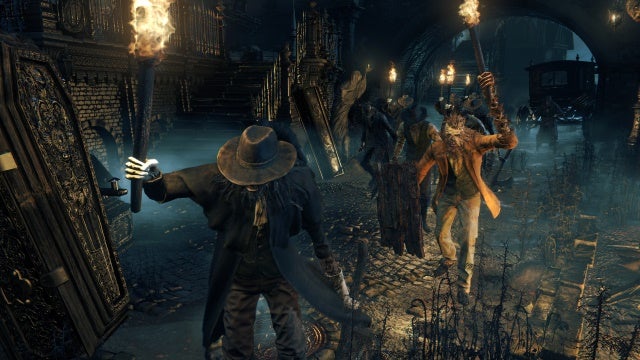
Verdict
Bloodborne is one of the very best games by FromSoftware, with heart-poundingly intense combat and ruthless difficulty. To see all it has to offer requires upwards of 40 hours, but this game is all about the journey, not the final destination.
Pros
- Smart level design
- Consistent, satisfying mechanics
- Thick, moody atmosphere
Cons
- Frequently frustrating
- Obscure style may annoy
Key Specifications
- Review Price: £47.99
Available exclusively on PS4
Purgatory. Getting the chance to re-live every painful moment, every mistake you ever made, a thousand of times. The time your first pet died, that day you realised Santa Claus wasn’t real, the first time you got dumped: every classic stomach-sinking moment on a constant loop. For ever. Bloodborne’s world is a bit like a skewed version of that particular hell.
Sounds awful, doesn’t it? Well From Software has once again proved there’s a masochist in us all, because Bloodborne is one of the most compelling PS4 exclusives of this generation so far.
See also: Bloodborne Guide – Tips and tricks
Bloodborne already has a guaranteed audience, being a sequel to Dark Souls II in all but name, but for the sake of argument we’re going to assume you’re not yet convinced.
So exactly how hellish is Bloodborne? You’re a lone warrior, a hunter who wakes up in a town where everyone not shuttered away has been infected by a lycanthropic disease. Not a member of the Twilight fans’ support group? This means werewolves. The first enemies you’ll meet are the townsfolk in the early stages of the transformation.
You’re on your own. People are either out to kill you or will only speak to you through closed doors. It’s a lonely, doom-laden world whose soundtrack is inhuman groans and ominous drones rather than rousing strings. The Elder Scrolls V: Skyrim this is not, and the Bloodborne leans more towards horror than From Software’s previous games.
Grim? Absolutely. Playing Bloodborne while knee-deep in a regretful weekend hangover isn’t the best idea, but there’s something intoxicating about the atmosphere. It’s quite unlike anything available for the current consoles, its approach quite different.
See also: PS4 vs Xbox One
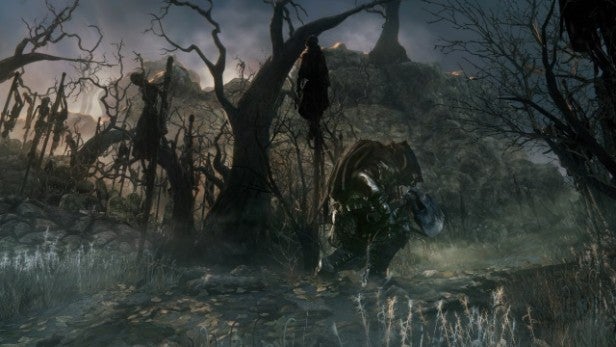
The lack of a traditional score is part of it, but the whole setup is unusual: if extremely similar in style to that of Dark Souls 2 and the other Souls games. Bloodborne doesn’t so much have story as a mythos. You’re not given a plot or quest to follow, but a rich world starts forming if you pay attention to your surroundings and the snippets of dialogue you get from the few characters who don’t want to tear your throat out.
None of it makes any sense on its own, but try to decode it within Bloodborne’s wider world and you can’t fail to get sucked in. Bloodborne’s swimming pool may be filled with blood, but it sure is warm.
This deep-diving doesn’t only apply nerd-out obsessives either. It’s not hard to end up uncovering much of what is there to find in Bloodborne’s environments, because you’ll meet them again and again. And again.
See also: PS4 vs PS3

Its difficulty level is much closer to a classic game like Megaman rather than the more recent third-person action games it may at first appear to have more in common with. Dying a dozen times an hour is not uncommon, after which you’ll reawaken at the last continue point you visited, with all enemies fully stocked-up again.
Watch a few minutes of Bloodborne gameplay and you’ll see our hero running around slashing at enemies in a manner that may appear brainless and button mash-y. That approach will get you nowhere, though. While some conventions of the third-person action RPG genre apply: you have multiple attack strengths and can roll out of the way of enemies, giving you the dexterity edge over most, you need to study Bloodborne in quite an active way.
Enter a new area and an enemy will, often as not, ambush you from the side and promptly lop off half your health. Next time, you’ll know the location of that enemy. Perhaps there’s a new kind of enemy is in this area too, and its attack pattern outfoxes you. Again: dead.
But then next time you’ll know to try to study its moves to avoid ending up with a spear up your backside.
See also: Best PS4 Games
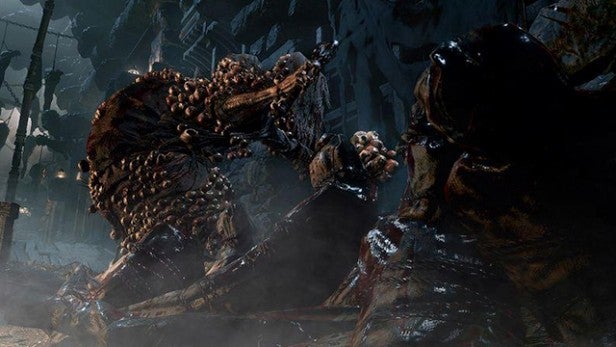
This same pattern of gradual learning amid plenty of failed attempts may be too much for some to stomach, but is what has become the key draw of From Software’s games. It has nothing of the handholding style of most modern games. It demands effort and attention.
For those whose bedrooms aren’t pasted with Dark Souls posters, From Software’s previous titles in this series are Demon’s Souls (2009), Dark Souls (2011) and Dark Souls 2 (2014).
See also: Upcoming PS4 Games

Arriving just a year after the much-praised Dark Souls 2, Bloodborne was always at risk of being accused of simply being “more of the same”. And to a great extent it is. If you’ve tried and hated the previous games in this sort-of series, Bloodborne is unlikely to turn you around. It’s still wilfully obscure and unendingly frustrating.
However, there are some new twists for the fans. Bloodborne removes the safety net of a shield. You can carry a weapon in each hand, a gun/firearm in one and an and axe, sword or hammer and so on in the other, but the kind of active defence you may have relied on in Dark Souls 2 is absent. While there are different character classes, all have to deal with close-up combat. A lot.
This forces you to take an aggressive combat style, especially as most of any health lost from attack can be regained by fighting back within a short window. Ranged weapons are for the most part not strong enough to be relied on either. You have to get stuck in, or run.
As ever, evasion is usually an option too. You can run through groups of enemies in most cases, and leaping out of the way of attacks plays just as important a role as attacking in combat. Its style is slightly different to the previous Souls games, but the feel is similar.
See also: PS4 HDD Upgrade – How to upgrade your PS4 storage
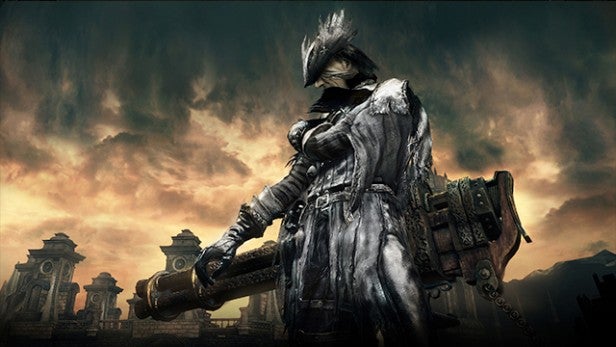
However, Bloodborne’s action-heavy approach puts even more of a focus on technique and timing. This is as important for game balancing as giving the fighting a distinct character. Unlike Dark Souls 2, enemies do not start to disappear after you’ve mined an area so many times. This was used as a way to deter players from simply levelling-up their characters to minimise the difficultly of what was to come ahead in Dark Souls 2.
As you can’t really take on enemies from a distance, and are more-or-less always vulnerable, this isn’t so much of a problem in Bloodborne. You still level-up stats, using a currency called Blood Echoes, retrieved from enemies, but the process of learning and studying environments and enemies is mandatory.
The only times this gets truly testing is when up against boss enemies. You’ll encounter one of these in every area, and need to take them on to progress to new areas. They’re not optional, and are often nightmarish giants that can take you up to 15-20 minutes to kill.
See also: PS4 FAQ – Things you need to know about Sony’s new gen console
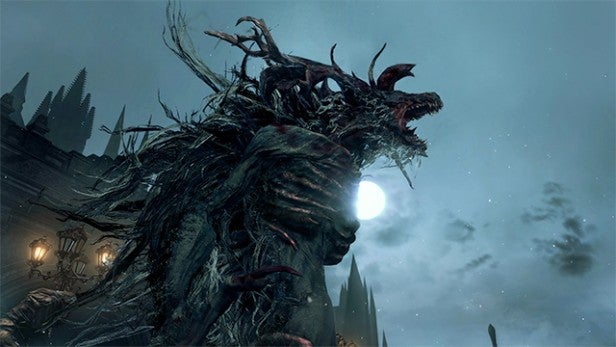
Boss battles often see the generally-high frustration level of Bloodborne reach new heights, especially as the failure to land that critical hit can come down to the crude way your character interacts with the environment.
Take the second boss battle as an example (minor spoilers): it takes place in a graveyard and is extremely reliant on you dodging attacks. However, the collision detection is so simple that you need to be doubly careful about your surroundings. The rules Bloodborne lives by are consistent, but rarely forgiving.
A few times we wondered whether From Software was taking a little too much glee in those repeated deaths – Bloodborne: Schadenfreude edition, anyone?
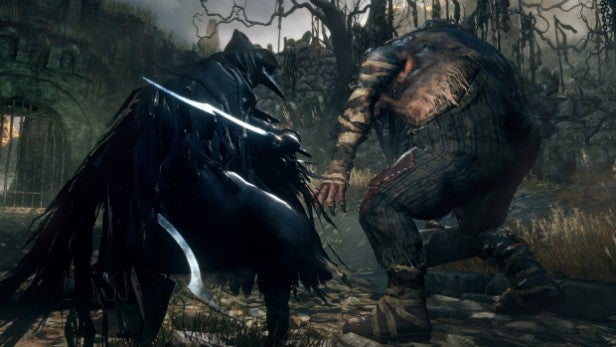
However, these little slips are rare. And otherwise, the world of Bloodborne has an unusual consistency. It’s a puzzle cube that fits together perfectly. Take a lift up a floor and you’re not simply whisked away to another area, with the lift acting as a hidden loading screen. You’ll actually be taken up a floor, and what is there will be structurally linked to where you were before.
This attention to detail and an above-and-beyond architect-like approach to world-building is another important part of the game, though, not just the level designers showing off. Continue points are scarce, and Bloodborne often routes you back to one unlocked previously. They’re called Lamps here, a slightly more modern take on the bonfires of Dark Souls 2. That feeling of being ‘back at square one’ is a deliberate oppressive move, but every unlocked door is progress.
By routing you around the same alleys, Bloodborne also makes you as familiar with its world as its creators are. Rarely does a game make you have such an intimate a relationship with environments this awful.
There’s beauty in them too, of course. This is far from one of the PS4’s best-looking games, but there are plenty of grand vistas that act both as eye candy and a way to stop Bloodborne’s oppression from weighing too heavily. It’s a dungeon crawler in some respects, but its environments are as often epic as claustrophobic. From Software has been very careful about that particular balancing act.
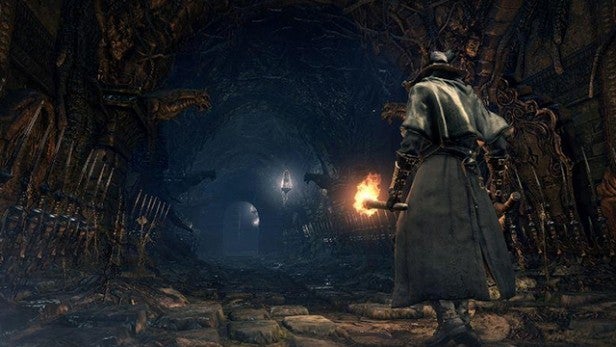
And while parts of Bloodborne’s levels link back to each other, there are also very clear wider zones. You do get to close the book on each tormented chapter in the end. There’s not much chance of you having a neutral response to any of them, either. Even if there are points when you breathe a sigh of relief and think (or scream) “thank god that’s over”, they do at least challenge, and satisfy.
The worst points have the most satisfying resolutions too, as you’ve inevitably win out using a specific technique rather than pure luck. Whether that’s of your own devising or something you looked up on YouTube hardly matters.
One gives you all the glory, the other hooks you into a sort of collective struggle against Bloodborne. For a game that’s stylistically a very lonely experience, there’s a strong community element to it too. You can watch spectres of other players throughout with hotspots that appear on the ground, and read notes they’ve left giving clues about what traps or goodies are ahead. You can leave your own notes too.
While we couldn’t get this feature to work pre-release (perhaps the world wasn’t populated enough), you can also summon other players to help you out in Bloodborne’s trickier battles. Again, as in previous Souls games. If that sounds like diluting the despair a bit too much, you can also play offline, leaving you well and truly on your own.
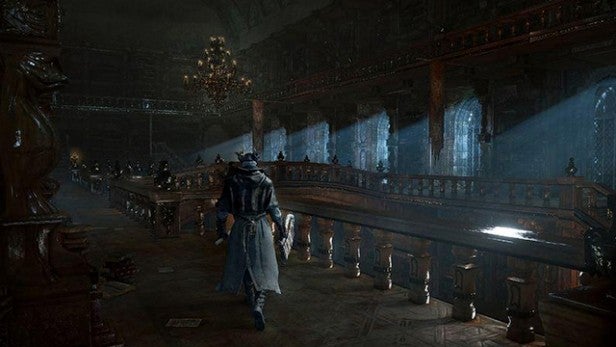
Verdict
Asking whether someone should buy Bloodborne or not should be countered with “do you think you can hack it?” Contrary to what some insufferable self-identifying ‘hardcore’ gamers may think, it doesn’t require masses of experience and being willing to sit down for six-hour sessions.
However, you do need patience and have to be willing to work out Bloodborne’s rhythms. And at its worst that won’t always seem fun. It doesn’t go easy on you, and you really have to try hard at times to progress. Few games ask this of you these days.
In asking more of you, though, Bloodborne’s journey seems more vital, more memorable, and its tense moments more heart-poundingly intense. To see all it has to offer requires upwards of 40 hours, but more than most this game is all about the journey, not the final destination.

